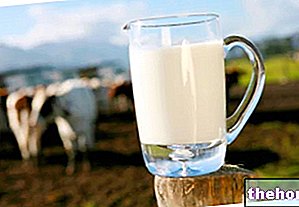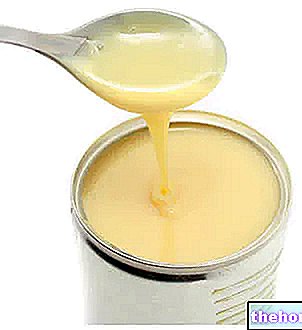Generalities and Types
Milk cream or fresh cream is a product that belongs to the II fundamental group of foods (that of Milk and Derivatives).
It represents a by-product of cow's milk, although it could be obtained from any type of animal milk.

- 10-12%: from cafeteria
- 30-35%: common or pastry
- 48%: double cream
In some countries of the world, cream is also marketed in different lipid percentages.
Obtained by skimming (natural surfacing or more commonly accelerated by centrifuges or "separators") of raw milk, and subjected exclusively to pasteurization, the "traditional Italian" cream must not be confused with cooking cream (sterilized with the UHT method ).
There are actually two types of fresh milk cream:
- Made from raw milk.
- Obtained from whey.
The first, the best known and distributed in our country, has a sweet, round flavor and typically recalls whole milk. The second, on the other hand, in addition to being leaner, has clear salty, spicy and typically "cheesy" notes.
Today freeze-dried milk cream is also available on the market, but it is mostly used in the commercial restaurant business.
Fresh (pasteurized) milk cream cannot be stored for a long time and must be kept in the refrigerator.
It has nutritional characteristics that are hardly compatible with clinical nutritional regimes, due to the considerable caloric intake provided by saturated fats.
From a gastronomic point of view, milk cream is the only cream of animal origin that can be whipped (whippeability). To better understand the whipping mechanism of the cream, we recommend reading the article: Fresh Cream: Why Whipping?
Nutritional Characteristics

Milk cream is a food characterized by a very high caloric intake, which is why it is not suitable for nutritional treatment for overweight and obesity.
Energy is mainly supplied by lipids, followed by carbohydrates and finally by proteins.
The portion of carbohydrates contained in the milk cream is made up of lactose; this characteristic places it in the group of dairy products. For this reason, traditional milk cream does not lend itself to the diet for lactose intolerance, even though delactosed variants have recently been marketed (in which lactose is already hydrolyzed or pre-digested into glucose and galactose).
ATTENTION! Delactosed cream is suitable for the diet against lactose intolerance but not for galactosemia.
Fiber and alcohol are absent.
The lipids of the milk cream are mainly saturated, followed by the monounsaturated and finally by the polyunsaturated ones. In addition, the cholesterol intake is more than significant.
These characteristics make milk cream a totally unsuitable food for hypercholesterolemic nutrition.
Although scarce, the peptides of milk cream are of high biological value and contain significant quantities of essential amino acids. The most abundant ones are glutamic acid, proline and leucine.
From a mineral point of view, the milk cream shows a fair amount of calcium and phosphorus. As far as vitamins are concerned, there is a fair amount of retinol equivalents (vitamin A).
Milk cream is a gluten-free food but, in addition to lactose intolerance and galactosemia, it must be excluded in case of allergy to cow's milk proteins (casein and / or whey).
It is admitted by the lacto-ovo vegetarian nutritional philosophy but not by the vegan one.
For the Jewish religion, cream is considered a kosher food, as it is made from cow's milk (a ruminant animal with a split hoof). Obviously, since it is made from milk, it cannot be eaten together with meat and the consumption of the two foods must be separated for at least 6 hours.
Milk cream is also tolerated by the Muslim religion (halal food) and is the only food of animal origin tolerated in Hinduism.
Hints of Gastronomy
Milk cream, normal or whipped, is used as an ingredient in many recipes, including cold desserts, pastry bases, creams, puddings, cakes, ice creams, sauces, soups, sauces for first courses, stews, etc.
The sweetened whipped cream is called chantilly cream and is served as a decoration / condiment in: ice cream cups, smoothies, hot chocolate and alcoholic beverages (eggnog, zabov / vov, Irish cream, bombardino etc.).
In the United States and Canada it is common to add cream (10-12% or 20% coffee) to American coffee, some use it instead of milk in tea.
The function of milk cream in savory recipes is similar and adjuvant to that of raw egg yolk (although for different mechanisms). The higher the lipid fraction, the higher the emulsifying capacity. Ultimately, the addition of cream of milk prevents the so-called splitting or "separation" effect of the aqueous component from the fats (unavoidable if you replace the cream with milk).
Milk and Honey Cream
Problems with playing the video? Reload the video from youtube.
- Go to the Video Page
- Go to the Video Recipes Section
- Watch the video on youtube
Additives and Further Processing
Cream may contain added thickeners and stabilizers.
Among the thickeners we mention: sodium alginate, carrageenan, gelatin, sodium bicarbonate, tetrasodium pyrophosphate and alginic acid.
In addition, the milk cream can be further stabilized with a partial demineralization and the addition of sodium caseinate. This prevents it from separating into surface oily globules (“feathering” effect) which typically occurs after adding to hot drinks. The process is quite expensive and therefore rarely used.
Milk, Dairy Products and Cheeses Asiago Brie Burrata Caciocavallo Rennet Camembert Cheddar Milk Cream Crescenza Emmental Feta Milk Flakes Fontina Herbal Cheeses Lean Cheeses Cheeses rich in calcium Gorgonzola Gouda Grana Padano Gruyere Kéfalair Adapted milk Artificial milk Condensed milk Asphyxiated milk Goat's milk Sheep's milk Rice milk Soy milk Powdered milk and concentrated milk Skimmed and semi-skimmed milk Lactose-free milk Milk Vegetable milk Dairy products Lerdammer Mascarpone Montasio Buffalo mozzarella Mozzarella Whipped cream Cooking cream Fresh cream Parmigiano Reggiano Pecorino Philadelphia Primo Sale Provolone Ricotta Robiola Roquefort Scamorza Sottilette Squacquerone Taleggio Tomino Yogurt OTHER ARTICLES MILK AND DERIVATIVES Categories Alcoholic foods Meat Cereals and derivatives Sweeteners Sweets Offal Fruit Dried fruit Milk and derivatives Legumes Oils and fats Fish and fishery products Cold cuts S pezie Vegetables Health recipes Appetizers Bread, Pizza and Brioche First courses Second courses Vegetables and Salads Sweets and Desserts Ice creams and sorbets Syrups, liqueurs and grappa Basic preparations ---- In the kitchen with leftovers Carnival recipes Christmas recipes Light diet recipes Women's Day, Mum, Dad Recipes Functional Recipes International Recipes Easter Recipes Recipes for Celiacs Recipes for Diabetics Recipes for Holidays Recipes for Valentine's Day Recipes for Vegetarians Protein Recipes Regional Recipes Vegan Recipes




























